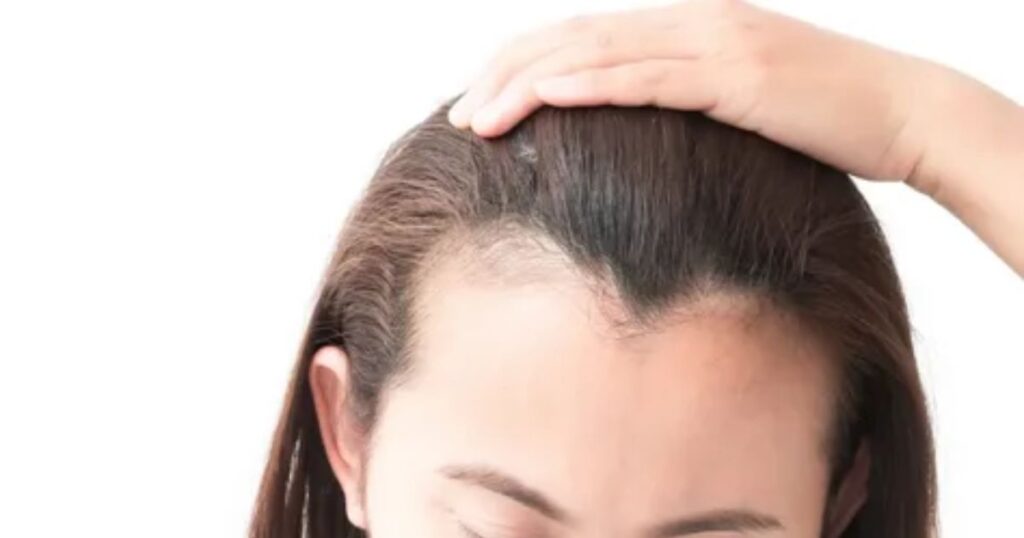Hair is not merely strands that adorn our heads; it holds immense significance, reflecting health, identity, and confidence. When we talk about the delicate issue of a receding hairline in women, it extends beyond aesthetics, often impacting self-esteem and emotional well-being.
In this comprehensive guide, we delve into the intricacies of how to stop a receding hairline woman. a query that echoes the concerns of many. Discovering effective strategies and empowering women with the knowledge to navigate this journey form the core of our exploration.
Hair health is a complex interplay of genetics, hormones, and lifestyle factors. As we navigate through the various dimensions of stopping a receding hairline in women, it’s crucial to recognize the multifaceted nature of this challenge. Empowering women with insights into the causes and solutions not only addresses the immediate concern but also fosters a sense of control and confidence in facing this common yet often stigmatized issue.
Understanding the Dynamics of Female Hair Loss
Female hair loss is a complex matter. It involves factors like genetics, hormones, and lifestyle choices. Knowing these dynamics is crucial for addressing and managing the issue effectively. When women experience a receding hairline, it’s not just about appearance.
It can impact self-esteem and emotional well-being. Exploring the causes and solutions helps women gain control and confidence in dealing with this common challenge. Understanding the dynamics of female hair loss is the first step toward finding effective solutions and fostering a sense of empowerment.
Hormonal Factors
Hormonal factors play a significant role in a woman’s battle against a receding hairline. During life events like pregnancy, childbirth, and menopause, hormonal fluctuations can trigger hair thinning. Understanding and addressing these hormonal changes are vital steps in the journey to stop a receding hairline in women.
Women experiencing a receding hairline due to hormonal shifts can benefit from a balanced diet rich in vitamins and minerals. Nutrients like vitamins A, B, C, and E, along with iron and zinc, support overall hair health. Incorporating these elements into the diet can help mitigate hormonal imbalances and promote stronger, healthier hair.
Genetic Predisposition and its Impact on Women’s Hair Health
Many women face hair loss due to their family history. If your relatives experienced a receding hairline, you might too. Genetics plays a significant role in determining the health of a woman’s hair, influencing factors like thickness and susceptibility to hairline recession.
| Aspect | Information |
| Genetic Influence on Hair Loss | Hair health is often hereditary. If female family members experienced hair loss, there’s a higher risk for the individual. |
| Understanding Family History | Knowing the family’s history of hair health helps in predicting potential issues and taking preventive measures. |
| Impact on Hair Thickness | Genetic predisposition influences factors such as hair thickness, determining the overall density of a woman’s hair. |
| Susceptibility to Hairline Issues | Individuals with a family history of receding hairlines may be more prone to experiencing similar issues themselves. |
| Proactive Hair Care Practices | Recognizing genetic influences allows women to adopt proactive hair care practices to maintain and improve overall hair health. |
| Treatment Strategies | Tailoring treatments based on genetic factors can enhance effectiveness, addressing specific issues associated with hair loss. |
Stress and Lifestyle
Stress and lifestyle choices play a pivotal role in the health of a woman’s hair. High-stress levels can disrupt hormonal balance, leading to hair thinning and a receding hairline. It’s essential to incorporate stress-management techniques like meditation or yoga to promote not only overall well-being but also to maintain healthy hair.
Daily lifestyle practices, such as a balanced diet and gentle hair care routines, contribute significantly to preventing a receding hairline. Opting for nutrient-rich foods and avoiding harsh chemical-laden hair products helps in nourishing the hair and preserving its strength. By making mindful choices in managing stress and daily habits, women can actively contribute to the health and vitality of their hair, minimizing the risk of a receding hairline.
Building a Hair-Healthy Diet

A hair-healthy diet is essential for strong and vibrant locks. Include foods rich in vitamins A, B, C, and E, like spinach and nuts. These nutrients nourish hair follicles, promoting growth and preventing a receding hairline. In addition to a balanced diet, adopt simple practices like tying your hair to prevent hair loss.
Limit processed foods and sugars, opting for a mix of proteins, fruits, and vegetables. This ensures your body receives the essential nutrients for robust hair health. Incorporating these habits contributes to luscious, resilient hair while tying your hair becomes an additional measure in preventing hair loss.
Massage and Stimulate
To boost hair health, try a simple scalp massage using your fingertips. Gently move in circular motions to enhance blood flow, promoting hair growth naturally. This manual approach stimulates the hair follicles, providing a cost-effective and relaxing solution.
Incorporate natural oils like coconut or olive oil during your massages. These oils nourish the scalp, strengthening hair strands from the roots. A few minutes of this manual stimulation a few times a week can make a noticeable difference in promoting healthier, fuller hair.
Gentle Hair Care Practices
Gentle hair care practices are vital for keeping your hair healthy and vibrant. Avoid harsh chemicals in shampoos and opt for mild, natural alternatives. Embrace loose hairstyles to reduce tension, and handle wet hair with care to prevent breakage. With a manual touch, these simple practices contribute to the overall well-being of your hair.
Choose soft brushes and wide-tooth combs to detangle without causing stress to your hair. Allow your hair to air-dry whenever possible to minimize heat damage. Regular trims prevent split ends, maintaining the strength and thickness of your hair. By adopting these gentle practices, you ensure that your hair stays resilient and beautiful.
Prescription Medications
Prescription medications offer a direct approach to tackling receding hairlines in women. These drugs, often recommended by dermatologists, work by addressing hormonal imbalances that contribute to hair loss. They provide a targeted solution, promoting hair growth and slowing down the progression of a receding hairline.
Women experiencing hormonal fluctuations, especially during pregnancy or menopause, may find prescription medications a valuable tool. These drugs actively counteract the factors leading to hair thinning, offering a practical and medically supported means to address and potentially reverse a receding hairline. Consultation with a healthcare professional is crucial to determine the most effective prescription medication tailored to individual needs.
Innovative Therapies
Innovative therapies offer hope for women combating a receding hairline. Procedures like Platelet-Rich Plasma (PRP) therapy involve injecting the patient’s plasma into the scalp, stimulating hair follicles for potential regrowth. This cutting-edge solution showcases promising results, providing a ray of optimism in the quest to address hair loss.
Low-Level Laser Therapy (LLLT) stands out as another non-invasive innovation. Using low-level lasers, this technique stimulates hair follicles, promoting growth without resorting to surgical measures. These modern therapies signify a shift towards advanced, effective solutions, offering women a range of choices in their journey to stop and reverse a receding hairline.
FAQs
How can I prevent a receding hairline as a woman?
Adopt a healthy lifestyle, including a balanced diet, regular scalp massages, and stress management. Use gentle hair care practices to minimize damage.
Are there specific products for women to stop a receding hairline?
Yes, topical treatments containing minoxidil are available over the counter. Consult with a dermatologist for personalized recommendations.
What role does genetics play in a woman’s receding hairline?
Genetics can influence susceptibility to hair loss. Knowing your family history allows for proactive measures to address potential issues.
Conclusion
Addressing a receding hairline in women requires proactive steps. Start by consulting with a dermatologist or a hair specialist to identify the underlying causes. Adopt a healthy lifestyle, incorporating a balanced diet and managing stress. Explore hair care products designed to promote growth and thickness.
Consider hairstyles that minimize stress on the hairline. Understanding how to stop a receding hairline in women involves a holistic approach, combining professional guidance, lifestyle adjustments, and appropriate products for the best results.


Pingback: what causes female hair growth on chin